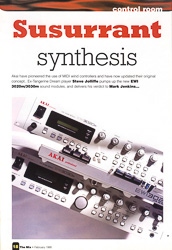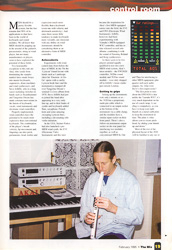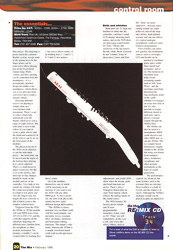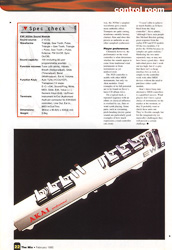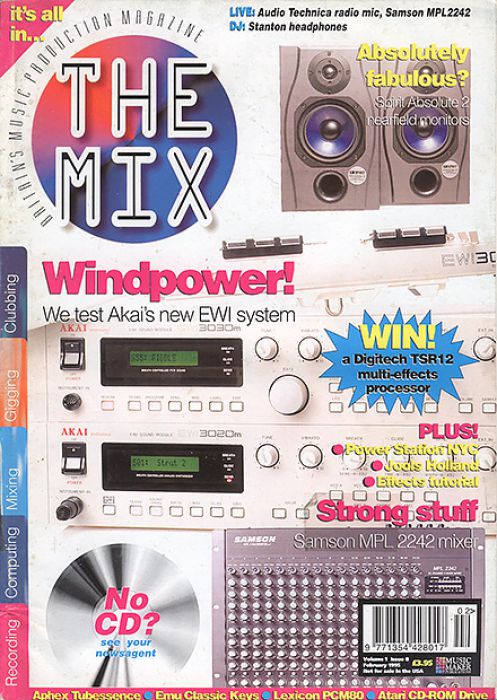Magazine Archive
Home -> Magazines -> Issues -> Articles in this issue -> View
Article Group: | |
Susurrant synthesis | |
Akai EWI 3020/3030 | Steve JolliffeArticle from The Mix, February 1995 | |
Wind controller and sound modules
Akai have pioneered the use of MIDI wind controllers and have now updated their original concept. Ex-Tangerine Dream player Steve Jolliffe pumps up the new EWI 3020m/3030m sound modules, and delivers his verdict to Mark Jenkins...

MIDI should be a pretty flexible system, but the fact remains that 90% of its applications to date have been in the world of keyboards and sound modules. We all know that MIDI should be popping up in the arsenal of the guitarist, percussionist, string or wind player, but not many manufacturers or players seem to have exploited the potential of these fields.
Two honourable exceptions to this rule are Akai, who (aside from dominating the sampler market) have made forays into master keyboards, sequencers, drum machines and wind synthesizers, and Steve Jolliffe, who in a long career including stretches in bands such as Steamhammer and Tangerine Dream has made constant innovations in the fusion of keyboards, vocals, wind instruments and electronic wind controllers.
Properly implemented, wind controllers have the potential to be much more expressive than conventional keyboards. The combination of the player's breath velocity, lip movements and fingering can alter pitch, portamento, bend, timbre and expression much more flexibly than a keyboard (even one with velocity and aftertouch sensitivity). And since there seems little tendency to make keyboards more versatile, any musician with any ability on wind instruments should be considering them as an alternative form of MIDI controller.
Antecedents
Experiments with wind control date from before the days of MIDI. In the 70s the 'Lyricon' found favour with bands such as Landscape (their hit 'Einstein-A-Go-Go' opens with a catchy Lyricon hook line) and the instrument is stamped all over Tangerine Dream's seminal Cyclone album from 1978. Steve Jolliffe had just re-joined the band after appearing in a very early line-up, and to their banks of synths and keyboards added flute, saxophone, French horn and some amazing swooping Lyricon lines, including a devastating solo violin imitation.
In the USA, Steiner-Parker had also launched a pre-MIDI wind synth, the EVI (Electronic Valve Instrument) and this later became the inspiration for Akai's first MIDI-equipped entries into the field, the EVI and EWI (Electronic Wind Instrument). Jolliffe, however, had been experimenting with Yamaha's MIDI-equipped WX7 controller, and has to date released several solo albums, combining it with the sound of Ensoniq, Roland and Korg synthesizers.
As there seem to be few players around equally qualified to test out a new MIDI wind system, Akai's latest models — the EWI3020 controller, 3020m sound module and 3030m sound module — were duly shipped off to Jolliffe's home studio just outside London.

Getting to grips
Setting up the instruments took only a minute or so — the 3020 has a proprietary multi-pin cable which is connected to an output socket at the bottom of the instrument via a cable clamp, and the modules have a similar input socket on their front panel. There's also a follow-on instrument output socket on the rear panel for interfacing two modules together, as well as conventional MIDI In, Out and Thru for interfacing to other MIDI equipment, plus quarter inch jack audio outputs. So, what were Steve's first impressions?
"The first point to note about the EWI3020 is that unlike the Yamaha WX7, it's very much dependent on the use of a neck strap. A sax sling is compulsory, as you have to keep your right thumb on a metal earth plate to keep the instrument in tune. The plate is what allows you to create pitch bend, by sliding your thumb up and down."
Most of the rest of the physical layout of the 3020 will be familiar to any sax or flute player. The fingering is pretty much the common Boehm system, except some of the sprung keys for the finger plates can be removed to allow playing just on the fixed metal contact rings. Pitch, volume and filter opening can be controlled from the mouthpiece — it's a permanently attached design not unlike a sax mouthpiece, which allows you to use pressure from your lower lip to create a manual vibrato.
Selecting different octaves for playing is simpler than on a conventional wind instrument. There's a set of rollers which falls underneath your left thumb, which gives you a range of eight octaves. The slide plate is next to the rollers (if you want to create a glide effect), and the depth and sensitivity of all the effects can be set on the front panel of the modules.
The physical layout of the 3020 can be adjusted to suit the individual player — the bend plate can be moved and the angle of the bottom three playing keys can be adjusted. There's a small preset to adjust sensitivity, but this is set at the factory, and most day-to-day changes should be made on the module and not on the controller. Very high or low sensitivity settings will make the connected module drone at a high or low pitch, and very dry fingers may not trigger the keys correctly (a dab of hand cream is the simplest solution here).
Triggered from the 3020, the 3020m or 3030m module will send MIDI notes from A# (22) to D# (111), and the controller supports all the substitute fingerings for different notes familiar from the saxophone or other acoustic instrument. For instance, a middle C can be created either by holding Key 3 one octave above centre, or by holding keys 1, 3 and 4, 7, 8, 9 and 12 two octaves above centre.
On to the modules themselves, one of which will be necessary as an interface if you want to use the 3020 with any other MIDI gear. As Steve points out, the units look physically similar but have quite different design philosophies.
"The 3020m is a basic analogue two oscillator synth with the usual triangle, saw and pulse waves, resonant filter, envelopes, memories and front panel editing functions. The output's only mono, whereas the 3030m is a sample waveform based synth with reverb and stereo outputs."

Bells and whistles
Both units are 2U high and finished in white like the controller; each has a small LCD display showing patch names, and on the 3020 there are dual-gang control knobs for Tune, Vibrato (the sensitivity of the lip sensor), Breath, Glide, Bend, External In and Volume. Some of these have Coarse and Fine adjustments, and small LEDs show when the breath, glide and bend functions are active. There's also a Transpose button plus an Auto Tune button, which reflects the analog nature of the sound source.
The 3020 features 50 factory preset sounds and 50 user-programmable memories. Some, such as S11 'Flute' are self-explanatory, in this case a soft, sine-wave like effect. Others, such as S01 'Strut' are more subjective — brassier, more cutting sounds are easily achieved, and all the deep bass drones, high-pitched screams and staccato effects of a typical analogue monophonic synth are easily found or programmed.
Foot switches can select new patches and modulation sources such as envelopes. LFO and breath can be patched to oscillator pitch, pulse width, filter cutoff and resonance, and so on. The inclusion of Oscillator Sync helps create screaming sounds such as S48 'Sync Wave', and the envelopes used help determine the staccato/legato mode of the synth — whether it re-triggers on every new note or not. It's also possible to assign different chords to each note, and to process external sounds through the 3020m filter.
The 3020m can also be used as a monophonic MIDI synth slaved to any other MIDI unit, as can the 3030m. This is a sample-based instrument, roughly similar to the 3020m but using waveforms from trumpets, oboes, trombones, saxophones and other acoustic instruments as the basis of sound generation.
The performance controls are identical, but some features such as the resonant filter are missing. However there is a built-in reverb, and the output is in stereo. Although the 3020m's analogue sounds can be played in quite an expressive way, the 3030m's sampled waveforms give a much more authentic effect. Trumpets are quite cutting, trombones suitably boomy, clarinet, flute and oboe-like presets as authentic as any other samploid synthesizer.

Player preferences
Ultimately however, the performance on the wind controller is what determines whether the sounds appear to come from traditional wind instruments or from instruments as yet undiscovered.
The 3020 controller is usable with other MIDI instruments, but only via Akai modules. Good examples of its full potential are to be found on Steve's latest CD album Alien.
On a typical track, a repeated sequence with an ethnic or classical influence is overlaid by sax, flute or wind synth playing. Some parts, such as screaming, pitch-bending electric guitar sounds are particularly good examples of how much expression a wind controller can create.

"I wasn't able to achieve as much fluidity as I'd have liked from the Akai controller", Steve admits, "although I have seen people like Michael Brecker getting great response from the earlier EWI and EVI models. Of the two modules, I'd prefer the 3030m because its samples are quite realistic." Marketing the two units separately may or may not have been a good idea — their individual prices don't work out too high, but it's a pity that there isn't a cheap interface box as well, to simply let the controller work with other MIDI devices without the need to purchase either synth module.
Akai's latest foray into alternative MIDI controllers is a qualified success. Wind players don't have a great choice of instruments on the market at the moment, so they'll probably want to check these units out. They're flexible enough, but for the imaginatively (or musically) challenged, they will present a certain challenge.
The essentials...
More from: Akai UK, (Contact Details)
Spec check
| Sound source: | 2 VCOs |
| Waveforms: | Triangle, Saw Tooth, Pulse, Triangle + Saw Tooth, Triangle + Pulse, Saw Tooth + Pulse, External, FM On/Off, Sync On/Off) |
| Sound capacity: | 100 (including 50 user programmable sounds) |
| Function volumes: | Tune (±50 cents), Vibrato, Breath (Sense/adjust), Glide (Time/adjust), Bend (Width/adjust), Ext in, Volume |
| Function Keys: | Auto Tune (VCOs/VCF), Transpose (12 steps: E-C-+D#), Sound/Prog, Write, MIDI, Glide, Edit, Value (+/-), Numeric Keys (0-9), Up/Down |
| Terminals: | Instrument In/Out (Authorised multi-pin connector for EWI3020 controller), Line Out, Ext in, MIDI In/Out/Thru |
| Dimensions: | 483(w) x 90.6(h) x 434(d) mm |
| Weight: | 5.8kg |
On the RE:MIX CD

For a taste of what the EWI is capable of, listen to Steve Jolliffe's demo on the RE:MIX CD this month.
Publisher: The Mix - Music Maker Publications (UK), Future Publishing.
The current copyright owner/s of this content may differ from the originally published copyright notice.
More details on copyright ownership...
Control Room
Artist:
Steve Jolliffe
Role:
Musician
Related Artists:
Tangerine Dream
Gear in this article:
MIDI Controller > Akai > EWI 3020
No Javascript: Audio player is disabled
Re:Mix #8 Tracklisting:
| 34 | Akai EWI |
This disk has been archived in full and disk images and further downloads are available at Archive.org - Re:Mix #8.
Review by Mark Jenkins
Help Support The Things You Love
mu:zines is the result of thousands of hours of effort, and will require many thousands more going forward to reach our goals of getting all this content online.
If you value this resource, you can support this project - it really helps!
Donations for April 2025
Issues donated this month: 1
New issues that have been donated or scanned for us this month.
Funds donated this month: £4.00
All donations and support are gratefully appreciated - thank you.
Magazines Needed - Can You Help?
Do you have any of these magazine issues?
If so, and you can donate, lend or scan them to help complete our archive, please get in touch via the Contribute page - thanks!








